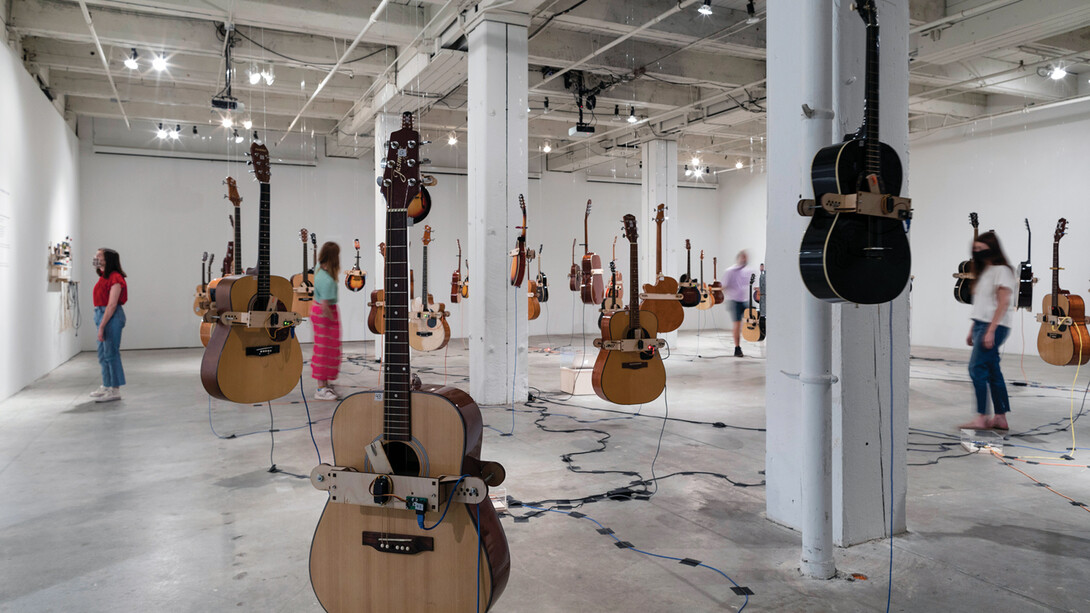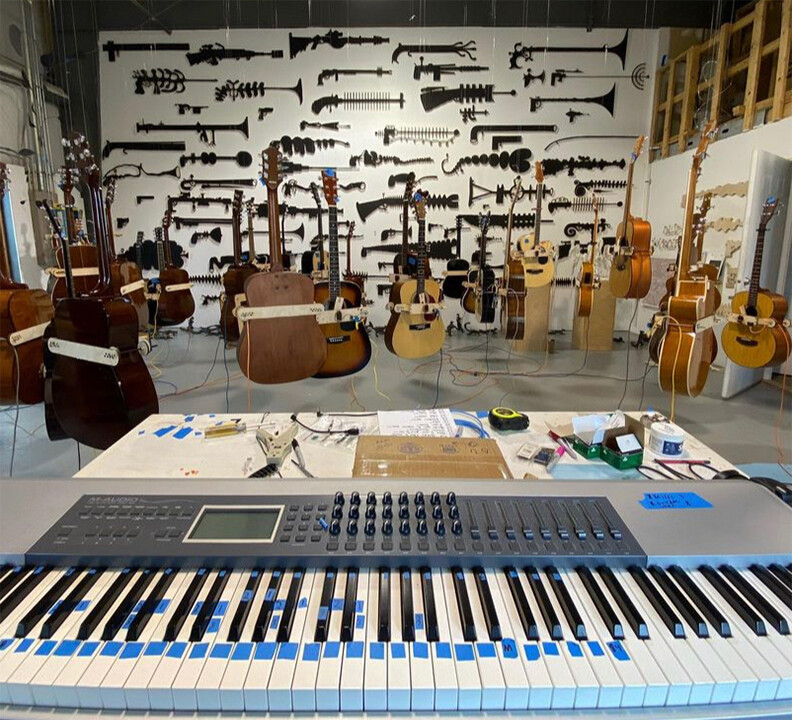
Nebraska’s Luke Farritor has hit a high note with his newest project.
A sophomore in the Jeffrey S. Raikes School of Computer Science and Management, Luke has helped notable Lincoln artist Charley Friedman bring to life a combination of art and ambiance that creates an otherworldly listening experience.
The resulting exhibit, “Soundtracks for the Present Future,” features 59 acoustic guitars, bass guitars and mandolins that hang via clear string from the ceiling at Omaha’s Bemis Center for Contemporary Arts. From a distance, it appears as though the instruments are floating through the air. And as one draws closer, another surprise awaits.
Suddenly music begins to fill the room. But it isn’t coming from a speaker or a hidden guitarist. Instead, each stringed instrument is playing a single assigned note from the piece. On their own, they sound strange; together, they create a new listening experience. As the notes bounce back and forth, a sonic symphony builds and fills the space.
While the music comes from the strings, the direction comes from the motors and circuit boards that Luke has engineered.
“That’s kind of where most of the magic happens,” he said.

The idea for the exhibit had been etched in Friedman’s notebook — and mind — for years. Around 2017, he reached out to another Farritor — Shane — for assistance with bringing the project to life. Friedman knew that Shane, Lederer Professor of Mechanical and Materials Engineering at the University of Nebraska–Lincoln, would have the connections that could bring his ideas to reality.
Shane instantly thought of his son, Luke.
Luke was only a sophomore in high school at the time, but he already knew he wanted to pursue engineering. His dad had noticed his knack for putting together LEGO when Luke was just a toddler and encouraged him to continue developing his talent through computer programming games and toy robotics.
“I’ve just kind of been curious about that as long as I can remember,” Luke said.
So when his dad asked if he’d be interested in helping with Friedman’s project, Luke jumped at the chance. Soon after, he was in Friedman’s west Lincoln studio brainstorming how to make a guitar play seemingly on its own.
Like many creative pursuits, the project went through a metamorphosis as the partners collaborated on its functionality. While they initially intended the exhibit to feature only acoustic guitars, Luke, Friedman and Nebraska doctoral student Jay Carlson found that the choice limited their musical range — and led to many broken strings. To hit the high and low notes that acoustic guitars just couldn’t produce, the trio brought in mandolins and acoustic bass guitars to round out the sound.
“It’s just a lot more range,” Luke said. “There’s a lot more you can do with it.”
After nearly four years of ideating in Friedman’s studio, many days spent laser-cutting guitar holders in Nebraska Innovation Studio, and hours of driving the guitars to Omaha, the exhibit was finally ready for assembly at the Bemis Center for Contemporary Arts.
The early June opening date was marked by a special performance from Nebraska’s Paul Barnes, Nebraska’s world-renowned pianist and Marguerite Scribante Professor of Music. While the exhibit typically plays music through a computer, the group was able to hook up Barnes’ keyboard to the same system. As Barnes hit keys, the associated notes reverberated back to him from the guitars and mandolins scattered around the room.
“He just played a recital like he plays a piano recital, except it was on these guitars and basses and mandolins,” Luke said.
The project’s official opening and first public recital were major moments for Luke, who grew up with “Soundtracks to a Present Future” — first as a high school student, now as a Husker. As the project has changed, he’s changed. And as he’s worked with creative minds like Friedman, he said he’s felt his own patterns of thinking shift.
“Just kind of sitting in the same room as though people who are artists… hearing how they think about things, learning about how they approach their careers, how they approach their lives, how they approach art… that was super valuable,” Luke said. “It really rubbed off on me, I think.”








